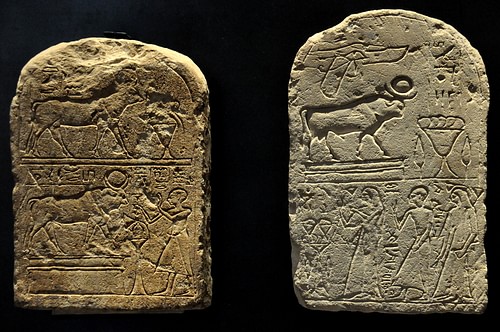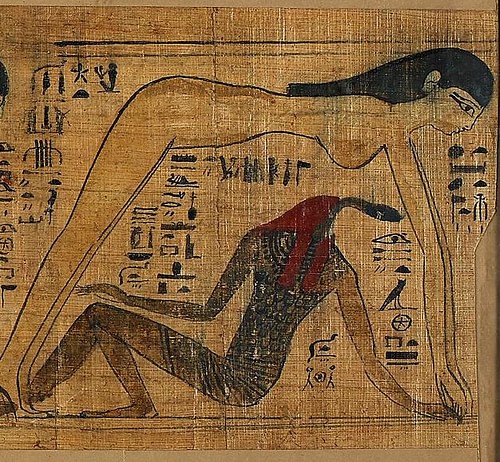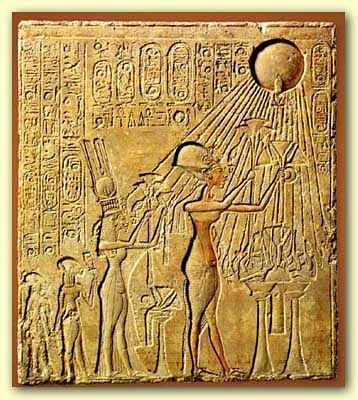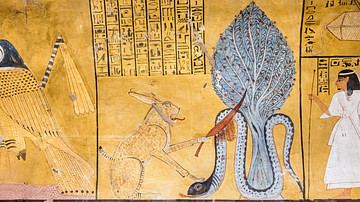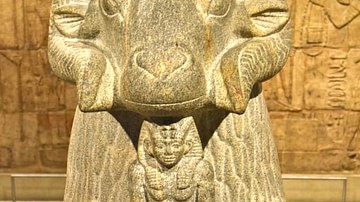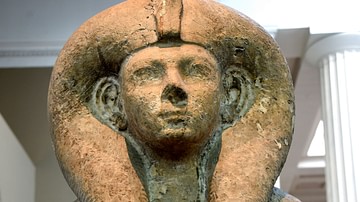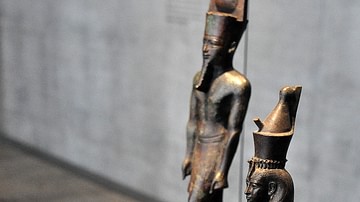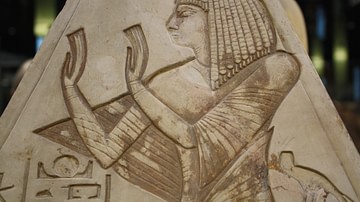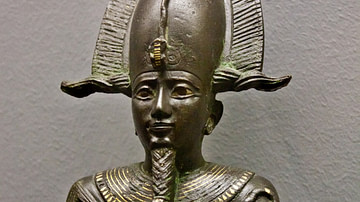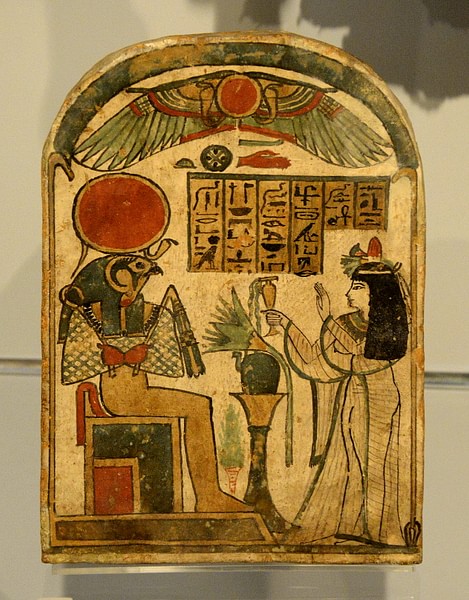
Ra (also given as Re) is the sun god of ancient Egypt. He is one of the oldest deities in the Egyptian pantheon and was later merged with others such as Horus, becoming Ra-Horakhty (the morning sun), Amun (as noonday sun), and Atum (the evening sun) associated with primal life-giving energy.
Ra is the Egyptian word for 'sun'. As a solar deity, Ra embodied the power of the sun but was also thought to be the sun itself, envisioned as the great god riding in his barge across the heavens throughout the day and descending into the underworld at sunset. As he made his way through the darkness beneath the earth, he was attacked nightly by the giant serpent Apophis (also known as Apep) who tried to prevent the sun from rising and so destroy all life on earth.
According to scholar Richard H. Wilkinson, Ra is "arguably Egypt’s most important deity" not only because of his association with the life-giving sun but also through his influence on the development of later gods (205). Amun, who would become so popular that his cult was almost monotheistic in devotion and the most powerful in ancient Egypt, developed from Ra and shares much of his mythology. Horus, who was associated with the living king, followed this same paradigm as Ra was known as “king and father of the king”. He was also associated with the creator god Atum and the two deities' names are used interchangeably in some versions of the creation myths.
Wilkinson suggests breaking any discussion of Ra into five sections addressing his various roles and functions:
- Ra in the Heavens
- Ra on the Earth
- Ra in the Netherworld
- Ra as Creator
- Ra as King and Father of the King
This course of study is suggested for this deity more so than others because of the scope of his powers, the important part he played in Egyptian religion, and his long history. Worship of Ra was already established by the time of the Old Kingdom of Egypt (c. 2613-2181 BCE) and continued for almost 2,000 years until, like the other Egyptian gods, he was eclipsed by Christianity.
Early Depiction, Origin, & Worship
Ra is first mentioned in the Pyramid Texts (c. 2400-2300 BCE), the oldest religious works in the world, which were inscribed on the sarcophagi and walls of tombs at Saqqara. In these, Ra gathers the soul of the king to himself and takes him to the paradise of the Field of Reeds in his golden barge. Worship of Ra was already well established at the time these texts – which are thought to derive from a much earlier oral tradition – were inscribed. His cult center was at the city of Iunu (better known as Heliopolis, the Greek name, which means “city of the sun god”). Ra is depicted in the Pyramid Texts not only as the supreme ruler of the gods, nor simply a comforter of the newly arrived soul in the afterlife, but as the embodiment of divine order and balance.
He was known as the Self-Created-One who appears in creation myths as the deity (interchangeably known as Atum) who stands on the primordial mound amidst the swirling waters of chaos and establishes order, gives birth to the other gods, and creates the world. Ra is enabled in this through the power of Heka who was both the god of magic and magic itself. Magic, to the ancient Egyptians, was a divine force which allowed for all that exists to be and also enabled transformation. Ra, as the first god, created heka and harnessed it, resulting in the birth of Heka who then maintained and controlled the divine magic afterwards.
Ra is therefore associated with this transformative power, which linked him with the sun that allowed for growth. Once associated with the sun, he was linked with Horus the sky god and solar deity (and was worshiped in this association as Ra-Horakhty) while, as creator-god, he was almost synonymous with Atum and, finally, as the champion of order and the seen and unseen world, with Amun, the ineffable representation of the nature of existence; in this capacity, he was known as Amun-Ra.
He is almost always depicted as the falcon-headed male Ra-Horakhty with the solar disc above his head although sometimes also shown as the scarab beetle below the solar disc (in this form he is known as Ra-Khepri. His worship was already well-established by the Second Dynasty of Egypt and took the form of sacrifices made in temples dedicated to him. By the time of the 5th Dynasty, kings associated their reigns with Ra, resulting in the construction of the Sun Temples of the period built to honor the god. From an early date, he was worshiped at Heliopolis in the form of the Mnevis bull, the living embodiment of Ra, comparable to the better-known Apis bull.
Ra in the Heavens
Ra is associated with the sky in the Pyramid Texts and already linked with the sun and life-giving energy, but a later text, known as the Book of the Heavenly Cow, provides the details of how Ra left the earth, which he once ruled directly, and ascended to heaven. The Book of the Heavenly Cow is thought to have existed in some form during the First Intermediate Period (2181-2040 BCE) and was written during the Middle Kingdom (2040-1782 BCE). All the extant scripts, however, come from the period of the New Kingdom (c. 1570 - c. 1069 BCE).
The story relates how Ra has grown old and his human subjects begin to plot his overthrow. Ra is upset and calls a council of the other gods who encourage him to smite the humans for their ingratitude. Ra summons The Eye of Ra, usually personified as a goddess, which is a powerful force that alternately does Ra’s bidding or breaks free of his control to wreak havoc. Either way, The Eye of Ra always brings some form of transformation and this story aligns with all others concerning the Eye in this regard.
Hathor is the Eye of Ra here and is released to destroy humanity. She kills thousands before Ra realizes what he has done and repents, begging her to stop. Hathor has lost all reason through the slaughter, however, and become the savage Sekhmet who, in her rage, cannot hear him. Ra orders 7,000 jugs of beer to be dyed red to resemble blood and has them poured out on the plains of Dendera. Hathor-Sekhmet drinks the blood-beer, passes out, and wakes as Hathor who pledges herself as a friend to humanity henceforth.
Ra is tired of ruling over humans, however, and asks the goddess Nut to carry him into the heavens. Nut turns herself into a celestial cow and takes Ra skyward on her back. On his way, Ra creates the Field of Reeds and organizes the administration of the world, leaving it to the other gods. Human beings will henceforth be responsible for maintaining order in keeping with the will of these gods and Ra, having retired, will only concern himself with driving his great barge across the sky.
Ra on the Earth
Prior to his departure, Ra ruled over his creation directly from earth. Ra created the laws which were later given to humanity by Osiris and Isis in the golden age of their reign before Osiris was murdered by his brother Set who usurped power (until he was defeated by Osiris’ and Isis’ son, Horus the Younger, who restored order). Ra’s presence on earth was recognized by sunlight and the growth of crops as well as the changing seasons. Wilkinson writes:
A specific and important example of Ra’s influence on the earth is seen in that the god was said to direct the three seasons of the Egyptian year – thus influencing the annual inundation of the Nile and the subsequent growing and harvest seasons. (206)
Ra was honored through Houses of Life, scriptoria attached to temples, where the works of scribes were kept under the protection of the god of writing Thoth and his consort (and sometimes daughter) Seshat. The written word, which recorded the past and so helped to maintain balance and order in the present, was given to humanity by Thoth but, as Creator of All, ultimately came from Ra. The Houses of Life, therefore, were considered emanations of Ra himself who also inspired correct interpretation of written works.
Ra in the Netherworld
Throughout the day, Ra sailed across the sky in his barge and then descended down into the underworld at night. The sun barge now transformed into the evening barge known as the Ship of a Million Souls which picked up the newly arrived and justified dead to bring them to the paradise of the Field of Reeds. Ra at this time becomes merged with Osiris, the judge of the dead, and Osiris is seen as the “corpse” and Ra as the “soul” of the single deity Ra-Osiris.
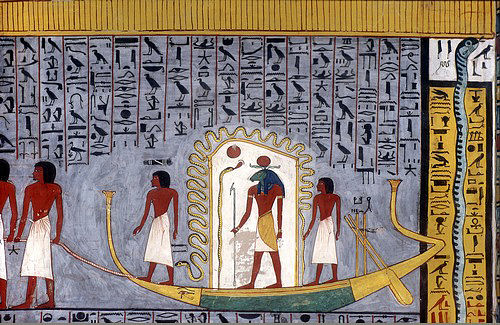
As this deity, Ra confers with Osiris on the deepest of levels, perhaps confirming which souls have been rightly justified before transporting them, and then traveling on through the underworld darkness toward the dawn of paradise. As the barge rolls through the underworld, it is attacked by the serpent Apophis who tries to kill Ra and prevent the sunrise. The gods onboard fight the serpent off with the help of the justified dead while, on earth, the living encourage the defenders through ritual ceremonies, channeling positive energies to strengthen those on board. Every night Apophis attacks, and every night he is defeated. Ra and his crew sail on toward dawn, the justified dead are delivered to their destination, and the sunrise was then seen as the sign that Ra was again victorious, and the Egyptians would see another day.
This was only one version of the soul’s journey toward paradise. In the New Kingdom work known as the Book of the Dead, the soul must stand in judgment before Osiris who weighs the soul’s heart against the white feather of truth (the feather of Ma'at, goddess of harmony and balance) and, if the scales remain even, the soul is allowed to proceed on (after Osiris confers with the Forty-Two Judges and other gods); if the heart is heavier than the feather, the soul would cease to exist. Ra was considered present at the judgement in his form as Ra-Osiris or invisibly as inspiration for Osiris’ just decision. Ma’at, one of Ra’s daughters, also embodied his presence at the judgment and was among his defenders on board the barge which, once dawn came, again transformed into the solar boat.
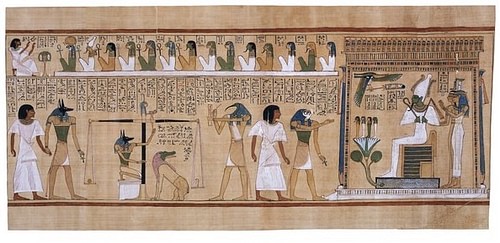
Ra as Creator
Ancient Egyptian mythology gives credit to a number of different gods for establishing order and making the world, but those most often featured in creation myths are Ra, Atum, Ptah, and the goddess Neith. Whichever gods are named, they always have the same characteristics and power as Ra, and it is thought that Ra was present – and alone – at the birth of creation no matter what name he was known by later. Although the priests of Ptah might claim it was their god who created all things, therefore, the Ptah they cite would actually be Ra. In the case of Atum, he was essentially Ra only by another name, and the same could be said for Neith in her creative capacity.
In the best-known version of the story, there was nothing but swirling waters at the beginning of time when the primordial mound (the ben-ben) rose as the first dry land and Ra the Self-Created stood upon it. He cut his penis open and, from the drops of blood, created Hu (authority) and Sia (mind), and then became aware of his solitude and mated with his own shadow to give birth to Shu (god of air) and Tefnut (goddess of moisture) who left to establish the world. The two were gone a very long time and so Ra sent the Eye of Ra to search for them. When the Eye brought his children back, Ra was so grateful he shed tears of joy which fell on the fertile ben-ben and became men and women.
Recognizing these people had nowhere to live, Shu and Tefnut mated and gave birth to Geb (earth) and Nut (sky). Geb and Nut gave birth to Osiris, Isis, Set, Nephthys, and Horus the Elder, and from these gods, all the others followed. Heka, among the oldest of the gods, is, as noted, thought to have been present already at the act of creation. Each of the gods was given their own sphere of influence so that order would be strictly maintained, and, in today’s parlance, there would be no duplication of services. The gods would henceforth care for the people and, in gratitude, the people would worship and obey the will of the gods. This relationship produced balance and harmony between the people, their gods, the earth, and the afterlife all of which emanated from Ra.
Ra as King & Father of the King
Balance was the most important cultural value of ancient Egypt, and it was modeled and maintained by the king. The ruler was thought to have been sanctified by the gods for his ability to keep order which was understood as balance/harmony. The founder of the 5th Dynasty of the Old Kingdom, the king Userkaf (r. late 26th century BCE), epitomized this ideal in elevating the Cult of Ra to the position of almost a state religion and encouraging his subjects to adhere to Ra’s values. Userkaf built the Nekhenre – the Sun Temple of Ra – near Abusir and established a tradition venerating Ra which continued throughout the dynasty.
Userkaf was the first king to erect a temple to Ra but all of his successors would follow suit, creating a model for the tradition of erecting temples in Ra’s honor which continued throughout Egypt’s history. The 5th Dynasty is best known for the sun temples as well as firmly establishing the link between a monarch and the gods. Userkaf and his successors referred to themselves as “sons of Ra” and were understood as literally being the children of the god. At this time, Ra was already recognized as king of the gods but was now known as "King and Father of the King" who maintained order through the just rule of his sons.
This policy established the king (known as pharaoh only in the New Kingdom) as the god’s own emissary on earth and demigod in his own right. By the time of the New Kingdom, Ra had been replaced by Horus as the god of the king while he lived and reigned and by Osiris after his death. In keeping with the belief that Ra was the Self-Created from whom all else came, however, it would still have been the power of Ra behind both Horus and Osiris.
Conclusion
Ra as the unseen power behind all other powers extended to every god in the Egyptian pantheon. Famous goddesses such as Bastet (protector of hearth and home), Hathor (goddess of joy, dance, music, and love), and Isis (goddess of magic, the moon, and healing) were all aspects of the life force of Ra as were their male consorts. Ra was the Giver of Life in the form of the sun who became associated with the Breath of Life in his form of Amun. He is sometimes depicted as Ra-Horakhty presenting the gift of life to a monarch by placing the symbol of the ankh to the king’s lips.
It is a testament to Ra’s enduring popularity that, during the reign of the so-called heretic king Akhenaten (1353-1336 BCE), when he closed down and outlawed every other cult, he allowed the cult of Ra to remain and worship to continue. This is no doubt because Akhenaten’s personal god, Aten, was a solar deity patterned closely on Ra and developed from both his and Amun’s attributes.
Once Akhenaten’s son and successor, Tutankhamun (r. c. 1336 - c. 1327 BCE), restored the old religion, Ra’s cult resumed its place among the many others and influenced their iconography. Even in depictions of other gods during the New Kingdom, images of Ra such as solar discs and falcon heads and sun’s rays make an appearance. The cult continued to exert this kind of influence, gradually waning during the Roman Period (30 BCE - 646 CE), until the rise of Christianity when the worship of Ra was abandoned in favor of the new god.
